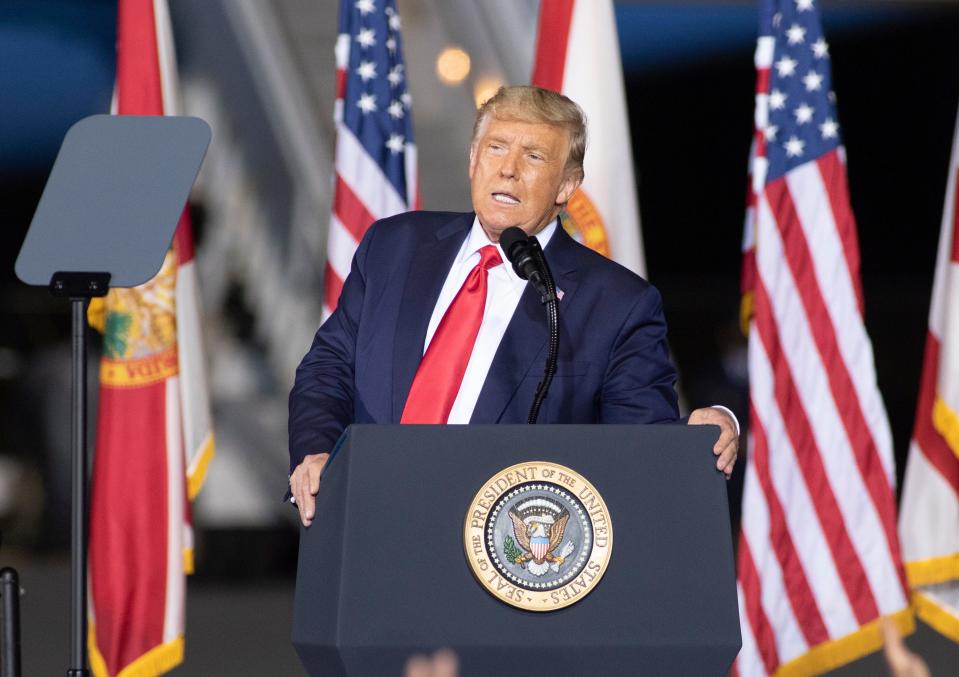Trump policies spur gun violence. Next president must use federal authority to stop it.
- Oops!Something went wrong.Please try again later.
President Donald Trump’s inability to condemn white supremacists and his callout to the Proud Boys from the presidential debate stage has drawn outrage from across the spectrum, as well it should. And while we are constantly subject to Trump’s verbal assaults, and are forced to consider whether his words will inspire violence, we must remember that his policy choices are causing violence every day.
As protests across the country have called for an end to racial injustice, the Trump administration has not only failed to address the root causes of police violence, but its actions will lead to an increase in gun violence.
Lessons from past episodes of police brutality are clear. Not only does police violence harm victims, but this violence diminishes the standing of law enforcement and destroys trust between law enforcement and the community. It impedes the ability of communities and police to work together to address violent crime, and that leads to more violence in the community.

After the death of Freddie Gray on injuries he suffered in the back of a Baltimore police van in 2015, the difficult relationship between the community and law enforcement frayed even further, likely contributing to record high gun violence in that city.
In 2020, gun violence and gun-related homicides have already claimed nearly 16,000 American lives. A recent analysis by criminologist Jeff Asher of 59 cities found that the number of homicide victims was up 28% compared with the same period last year. This spike in violence has not been confined to geographic or ideological boundaries; it is occurring in communities across America.
COLUMN: To our next president: 10 priorities for fixing our justice system
In cities such as Nashville and Indianapolis, the murder count is about 30% higher this year than it was at this time last year.
Even in small cities such as Aurora, Colorado, and Toledo, Ohio, the homicide rates are significantly higher. While fully unpacking what is driving the rise in the homicide rate could take years, it is hard to imagine that George Floyd’s death at the knee of a Minneapolis police officer in May and the spinal cord injury of Jacob Blake, shot in the back multiple times Aug. 23 in Wisconsin, and other incidents of police violence that diminish trust in law enforcement are not a contributing factor.
Unfortunately, the Trump administration’s hard-lined response to protests about police violence has only made matters worse. By sending federal troops to local cities, supporting armed vigilantes and vilifying community members seeking justice, the administration has contributed to the continued breakdown of trust between police and communities.
COLUMN: Economic struggles worsened under COVID-19 already existed under mass incarceration
A more thoughtful approach to federal power, however, could make communities safer. Rather than defending and inciting brutal police tactics and armed vigilantes, the federal government should invest in policies and programs that will reduce gun violence and build trust between police and the communities they serve.
The Trump administration has ignored effective interventions that approach the root cause of police violence. The federal government has the ability to require local law enforcement agencies to implement police accountability reforms. Both Attorneys General William Barr and Jeff Sessions criticized this authority as federal overreach.
In cities such as Los Angeles, Washington, D.C., and Ferguson, Missouri, reforms have focused on many of the same changes that activists seek — ending racial profiling, revising use-of-force standards and ensuring adequate training, supervision and discipline of officers.
The federal government has limited resources to investigate the nation’s 18,000 law enforcement agencies. Even so, the complete abdication of this authority is palpable at a time when local agencies could look to the federal government for expertise in implementing basic reforms.
In addition to ignoring police violence, this administration is also starving programs that address community violence and save lives. In 2019, the Department of Justice allocated only .02% of its $28 billion annual budget to support community-based violence prevention initiatives. While Trump warned Americans that former Vice President Joe Biden will defund the police, the divestment of funds to address community violence is already well underway on Trump’s watch.
POLICING THE USA: A look at race, justice, media
Programs that interrupt cycles of retaliatory violence and connect services to high-risk individuals can save lives. Yet instead of investing in a proactive approach, the Department of Justice seems to have divested from community programs, embracing a “boots on the ground” approach to address violence after it has happened.
The federal government has both the authority and tools to combat the twin crises of community-based gun violence and police violence. Let’s hope the next administration has the will to do it.
Josh Horwitz (@joshuamhorwitz) is executive director of the Educational Fund to Stop Gun Violence.
Kami Chavis (@ProfKamiChavis) is vice president for strategy and programming at the Educational Fund to Stop Gun Violence and is professor of law and director of the criminal justice program at the Wake Forest University School of Law.
This article originally appeared on USA TODAY: Donald Trump spurs gun violence that the next president must stop

